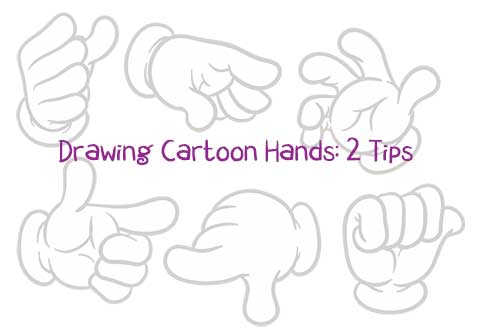Specifically, here are two drawing cartoon hands tips in the form of questions to help you troubleshoot your work and can get better, faster.

The two questions to ask yourself when drawing cartoon hands are:
- what is in front? and/or
- what is the outline?
Of course it is always important also to know which question to ask in which situation
Let’s start with Question #1…
“What is in front?”
Asking what’s in front is a good tip for a situation when you are drawing cartoon hands and parts of the hand are folded or bent across one another. It’s useful because it gives you a starting point for drawing the hand, and once you have a starting point you can tack the adjacent parts of the hand around it and that enables you to keep everything in proportion.
Sometimes you have a situation where two parts of the hand are in front (i.e. completely unobscured by other parts of the hand), in which case I suggest you start with drawing a finger rather than the thumb (if those are your options) because thumbs have some challenging curves whereas fingers are straight, which makes them easier to draw accurately.
And now it’s time for Question #2.
“What is the Outline?”
Asking this question is particularly applicable when you are faced with a fist, because in fists the fingers are all curled into the palm and often there is just a small tip or curve of the thumb visible. In these cases the angles of the outline become very important in conveying what the hand is doing.
The thumb is generally the maverick component of the hand, but that is a subject for another day. If you are feeling a bit frustrated with your thumb drawing abilities, console yourself with the knowledge that the thumb follows completely different rules from all the fingers — and of course drawing thumbs is also a learnable skill.
In the meantime, celebrate your thumbs as the opposable digits that set us primates apart from other mammals and make us so handy with our paws! And approach all hands by asking the two questions — either identify what is in front, or ask what’s the outline — to give yourself an easy starting point.
A final tip when drawing cartoon hands
Use a reference, or make the hand pose yourself and copy, especially if you are just starting out. All the best cartoonist use references, it’s not cheating, I promise ;).
Here’s your drawing cartoon hands video lesson so that you can see exactly how to put the questions to practical use:
Thinking about joining Da Vinci in August 2018?
The course opens for students on June 23 June 2018 at 4 pm (Eastern US).
Here’s what 2017 participant Dr John Kenworthy from Singapore had to say about his experience:
I was fearful that I couldn’t really draw. I’ve wanted to draw easily and well for 45 years – ever since I was thrown out of “Art” at school with the immortal words: “You will never be able to draw, Kenworthy!”. But I trusted Ali and I trusted the process.
I have tried online drawing lessons before and whilst I’ve had some success, I never found it easy and I gave up…
Perhaps I just needed a good teacher. And I finally found one.
Ali is a guide on the side. She gives a gentle nudge and an encouraging word with practical tips – sometimes a video, sometimes a correction on your own drawing. She’s looking out for everyone and drips feeds us with little learnings to take us one more step forward.
I would recommend Da Vinci if you want to add your own pizazz to an article or a blog post or your training courses, or maybe your marketing materials. Or if you love the idea of having cartoons and secretly always wanted to draw but just never made the time or were discouraged before.
I’ve enjoyed this course far more than I thought that I would. I feel confident drawing my character live in my workshops (not with all the background and detail yet, but with a certain flourish) that has helped my coaching and workshops take on an extra dimension of spontaneity and fun.
Interested? Click here to read more about the course (and find the waiting list).
